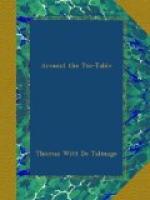CHAPTER XI.
A lie, zoologically considered.
We stand agape in the British Museum, looking at the monstrous skeletons of the mastodon, megatherium and iguanodon, and conclude that all the great animals thirty feet long and eleven feet high are extinct.
Now, while we do not want to frighten children or disturb nervous people, we have to say that the other day we caught a glimpse of a monster beside which the lizards of the saurian era were short, and the elephants of the mammalian period were insignificant. We saw it in full spring, and on the track of its prey. Children would call the creature “a fib;” rough persons would term it “a whopper;” polite folks would say it was “a fabrication;” but plain and unscientific people would style it “a lie.” Naturalists might assign it to the species “Tigris regalis,” or “Felis pardus.”
We do not think that anatomical and zoological justice has been done to the lie. It is to be found in all zones. Livingstone saw it in Central Africa; Dr. Kane found it on an iceberg beside a polar bear; Agassiz discovered it in Brazil. It thrives about as well in one clime as another, with perhaps a little preference for the temperate zone. It lives on berries, or bananas, or corn, grapes, or artichokes; drinks water, or alcohol, or tea. It eats up a great many children, and would have destroyed the boy who afterward became the father of his country had he not driven it back with his hatchet. (See the last two hundred Sunday-school addresses.)
The first peculiarity of this Tigris regalis or Felis pardus, commonly called a lie, is its
Longevity.
If it once get born, it lives on almost interminably. Sometimes it has followed a man for ten, twenty or forty years, and has been as healthy in its last leap as in the first. It has run at every president from General Washington to General Grant, and helped kill Horace Greeley. It has barked at every good man since Adam, and every good woman since Eve, and every good boy since Abel, and every good cow since Pharaoh’s lean kine. Malarias do not poison it, nor fires burn it, nor winters freeze it. Just now it is after your neighbor; to-morrow it will be after you. It is the healthiest of all monsters. Its tooth knocks out the “tooth of time.” Its hair never turns white with age, nor does it limp with decrepitude. It is distinguished for its longevity.




